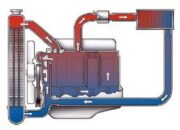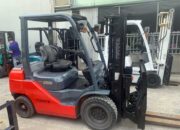How to extend the life of forklift batteries?
The electric forklift charger when charging needs to be equipped with a meter that displays the vehicle lights in normal circumstances. When the battery power drops from 70% to 100%, that is also the best charging time. When the electric forklift’s power source is short, it must be charged immediately to avoid the electric forklift’s power failure. Although the electric forklift control system has a power failure protection function, the power failure protection function will lose its effect for a long time. Over time, the capacity of the battery will gradually decrease. This will make the battery capacity of the electric forklift increasingly weaker.
When choosing a charger for an electric forklift, you must choose the right one, the original chargers that come with the electric forklift are all smart chargers. When using a smart charger, it will automatically determine how much capacity has been charged and how much battery is left. The charging current can be adjusted automatically, which can effectively activate the capacity of the battery and slow down the curing of the battery.
In fact, at normal times, you can also charge the electric forklift, even when the electric forklift is not working, there is still a lot of energy in the battery. You can also charge the electric forklift, at least it needs to be secured. It can be charged once a day, so that the electric forklift can operate in its empty cycle and prolong the life of the electric forklift battery.
In what cases should the forklift battery be replaced?
Over-vulcanization of forklift batteries:
Many electric forklift batteries are lead-acid batteries. The catalytic solutions used in these cells contain both sulfuric acid and water. Over time, water evaporates and needs to be replenished (pure water is used for industrial battery maintenance reasons). When the forklift battery has too little water or is not charged properly. The sulfuric acid in the catalyst solution can be deposited on the battery plates. This process is known as Acqui sulphation. A battery with too much sulfate will lose its starting power and take longer to charge. If left for too long, the battery leads may be damaged. Therefore, if a forklift operator finds that during a pre-charge inspection of a forklift battery, the sulfate level in the battery is too high to remove contaminants, the battery should be replaced.
Forklift battery drains abnormally quickly after charging:
Another obvious sign that your forklift battery should be replaced is if it doesn’t seem to be charging. When charging forklift batteries, the charging time and charge level of each battery can be noted in the maintenance log. Ideally, the battery should be charged to maximize its useful life when it reaches about 20-30%. Otherwise, you may find that the Acqui loses its ability to charge faster than usual. Remember that battery life is dependent on charge cycles, so using “fast charge” to fully charge the battery to 70% will only reduce its lifespan.
The performance, the control screen of the electric forklift is blurred
When the battery is installed, if the forklift operator notices a dim or flickering screen on the forklift (or doesn’t turn on at all), it could be a sign that the battery is not providing enough power. In some cases, the forklift truck may not move at all. If this happens, be sure to check that the connection between the battery and the forklift is solid. Also, be sure to check the inside of your forklift battery for signs of vulcanization.
Acid splashes outside the forklift battery:
If acid builds up outside of the battery, it should be checked immediately for signs of damage and may be ready for appropriate handling. Acid released from the battery can pose a serious health and safety hazard to personnel attempting to operate it. Handling a damaged forklift battery requires wearing gloves, goggles and other protective clothing to prevent acids from coming into contact with them. This could be due to a loose seal or a full battery, as catalytic fluid can squirt around inside the battery while the forklift is running. However, you should not attempt to replace lost sulfuric acid in a lead acid industrial battery. If it cannot be fixed it will cause an acid leak, send the battery for repair or the manufacturer to replace the battery with a new one. We recommend that you do not try to solve problems without expertise.
Corrosion/damaged forklift battery terminals:
Electric forklift batteries are generally highly durable. However, any device can be damaged if overused. For example, if an industrial battery is serviced too late or if something affects the battery terminals. Damage may cause the battery to not function properly. Corroded terminals can prevent the battery from efficiently transferring energy to the forklift and prevent it from charging. Damaged battery housings can cause leaks or prevent the terminals from making secure contact with the forklift. If the battery terminals are corroded or damaged, they must be sent to the manufacturer for repair or replacement. Here are some warning signs that you may need to replace your car battery







